FC København’s youth system has been a source of talent, nurturing players who have gone on to have a significant impact on football. Midfielder Thomas Delaney made over 170 appearances for the 15-time Danish champions before moving to the Bundesliga, where he donned the shirts of both Werder Bremen and Borussia Dortmund. Jonas Wind is another player whose career has followed a similar trajectory as he now plays for Wolfsburg.
We cannot talk about FC København’s youth system without mentioning the young starlet that is Roony Bardghji. The highly-rated Sweden U21 international made his first team debut for the club in 2021 at the age of 16 and six days, which saw him become the youngest player ever to play in a senior game for the Danish giants. Since stepping onto the scene, Bardhji has gone on to make over 50 appearances for the club and had a huge impact in big games such as the UEFA Champions League clash with Manchester United.
In this tactical analysis piece, we will undertake a scout report on another exciting prospect in the København youth setup. 16-year-old forward Roberto Risnæs is one of the standout performers in the Under 17s and Under 19s, and we will look into what makes him one to watch. The left-footed attacker can play anywhere across the front line: left wing, right wing or centre forward.
In this report, we will analyse how Risnæs fits into the tactics utilised by FC København U17s and U19s to pinpoint his unique skillset and show what makes him one to watch in the future.
Goals, goals, goals
We are going to kick this analysis off with quite an obvious starting point – goals. Naturally, as a forward, we would expect Risnæs to aid his team’s cause with his fair share of goals, and that is just what the youngster does exceptionally well.
A forward’s primary responsibility is to convert goalscoring opportunities into actual goals. The effectiveness of the team’s attack is directly tied to their ability to finish chances. Whether through accurate shots, volleys, or well-placed headers, a forward with the ability to find the back of the net becomes the focal point of a team’s offensive strategy, turning opportunities into tangible results on the scoreboard.
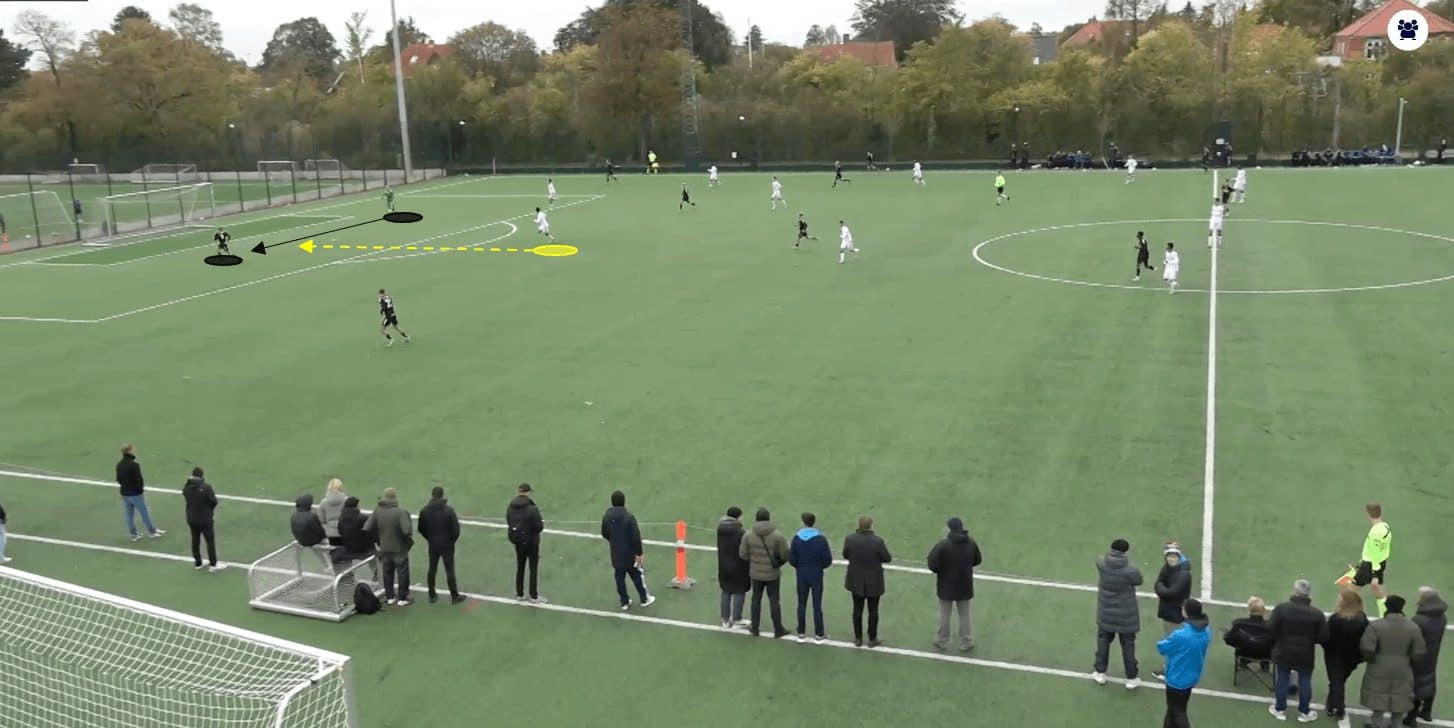
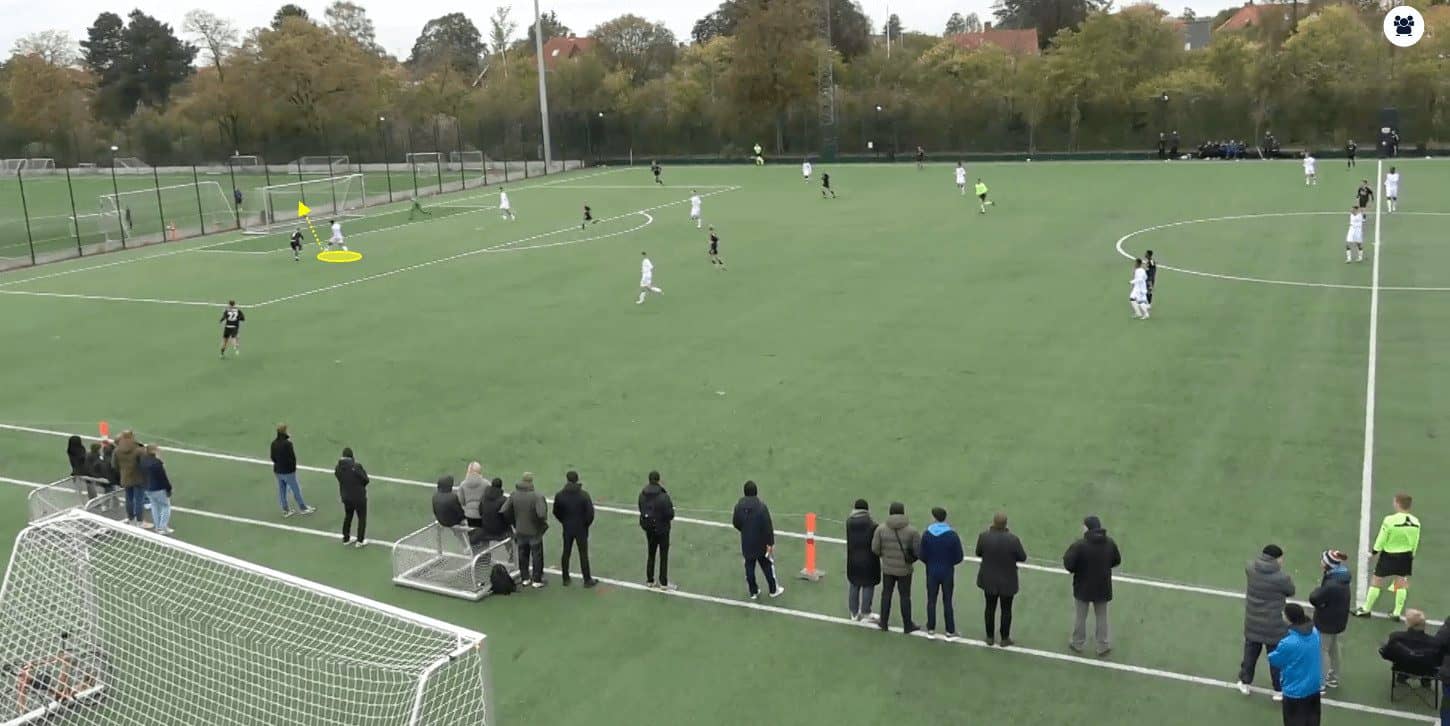
On this occasion, we can see that FC København adopts a high-pressing strategy which forces their opponents to play backwards. When it becomes evident that the goalkeeper is going to pass to his centre-back, Risnæs quickly moves to intercept the pass and, as a result, calmly passes the ball into the back of the net.
Risnæs is essential for exploiting defensive vulnerabilities. By staying attuned to the movements of opposing defenders and anticipating potential errors or lapses in concentration, he can seize opportunities to intercept passes or capitalise on defensive mistakes, as we see above. This proactive approach not only disrupts the opposition’s build-up but also creates goalscoring chances through turnovers in advanced positions.
Furthermore, his willingness to engage in high pressing is instrumental in setting the tone for the team’s defensive strategy. By applying pressure to the opposition’s defenders and limiting their time on the ball, he contributes to an organised defensive effort. Risnæs often forces the opposition into mistakes, thereby facilitating ball recoveries (4.5 per 90) high up the pitch.
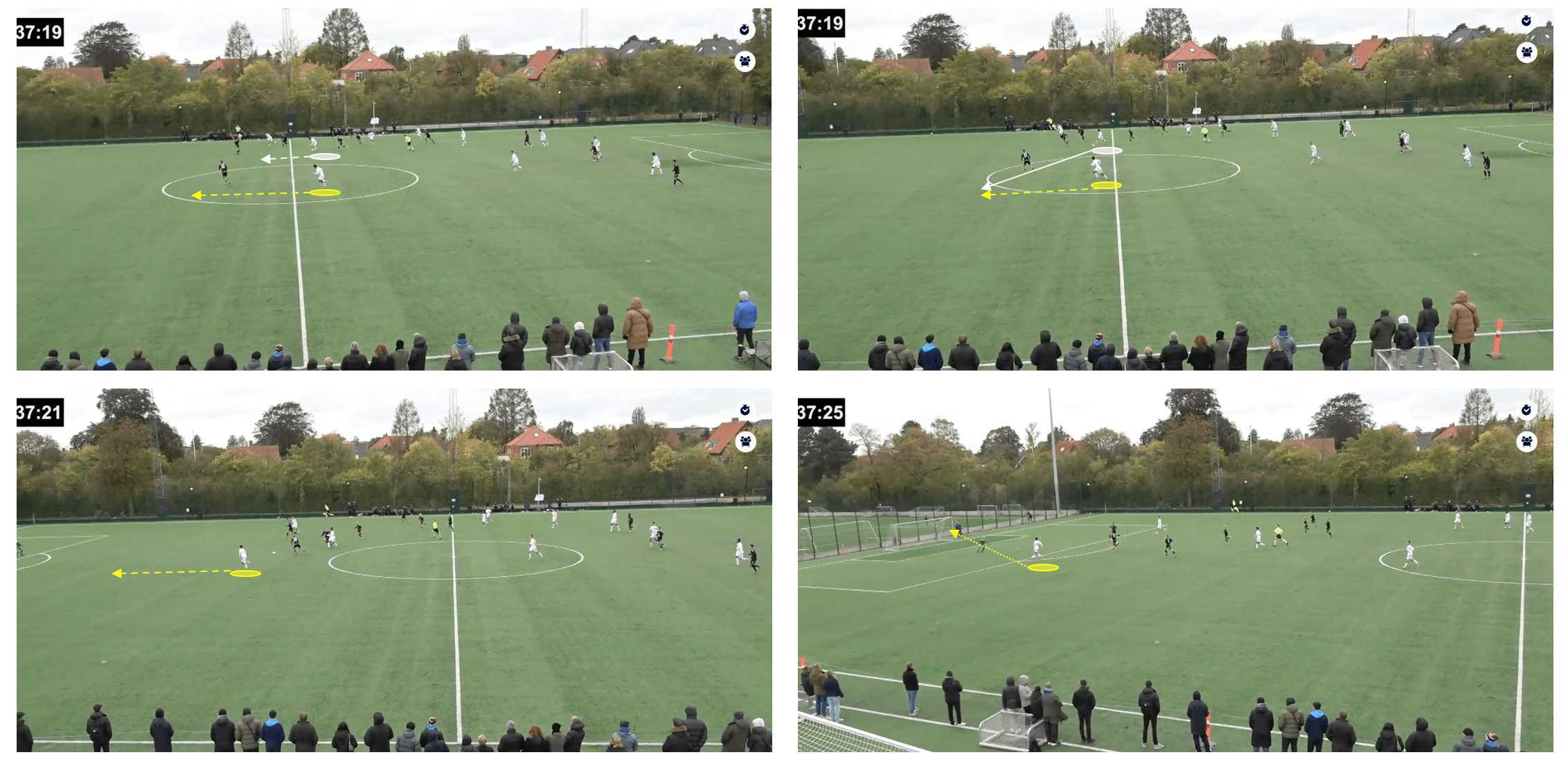
Moreover, as a high press is not always sustainable, FC København’s youth teams will look to sit back and invite pressure onto them, knowing they can utilise the speed of Risnæs on the counterattack. Here, we can see that when his team regain possession, the young forward’s first thought is to get forward. He makes a well-timed run, which sees him go through 1v1 with the goalkeeper. Risnæs places the ball into the far corner with his right foot.
Risnæs’ runs in behind the defensive line allow him to capitalise on his speed and agility. He gains a positional advantage when he accelerates into open spaces behind the defensive line, making it difficult for defenders to track him. This burst of pace is a potent weapon, enabling him to reach goalscoring positions ahead of the opposition and increasing the likelihood of converting chances.
The København forward averages 3.2 shots per 90 and 1.39 shots on target per 90. Additionally, most of his shots occur inside the opposition penalty area (2.8 per 90), which increases his scoring chances and means he avoids wasteful long shots.
Consequently, his clinical finishing instils confidence in the entire team. Knowing that Risnæs possesses the capability to score consistently means his teammates understand they can rely on him.
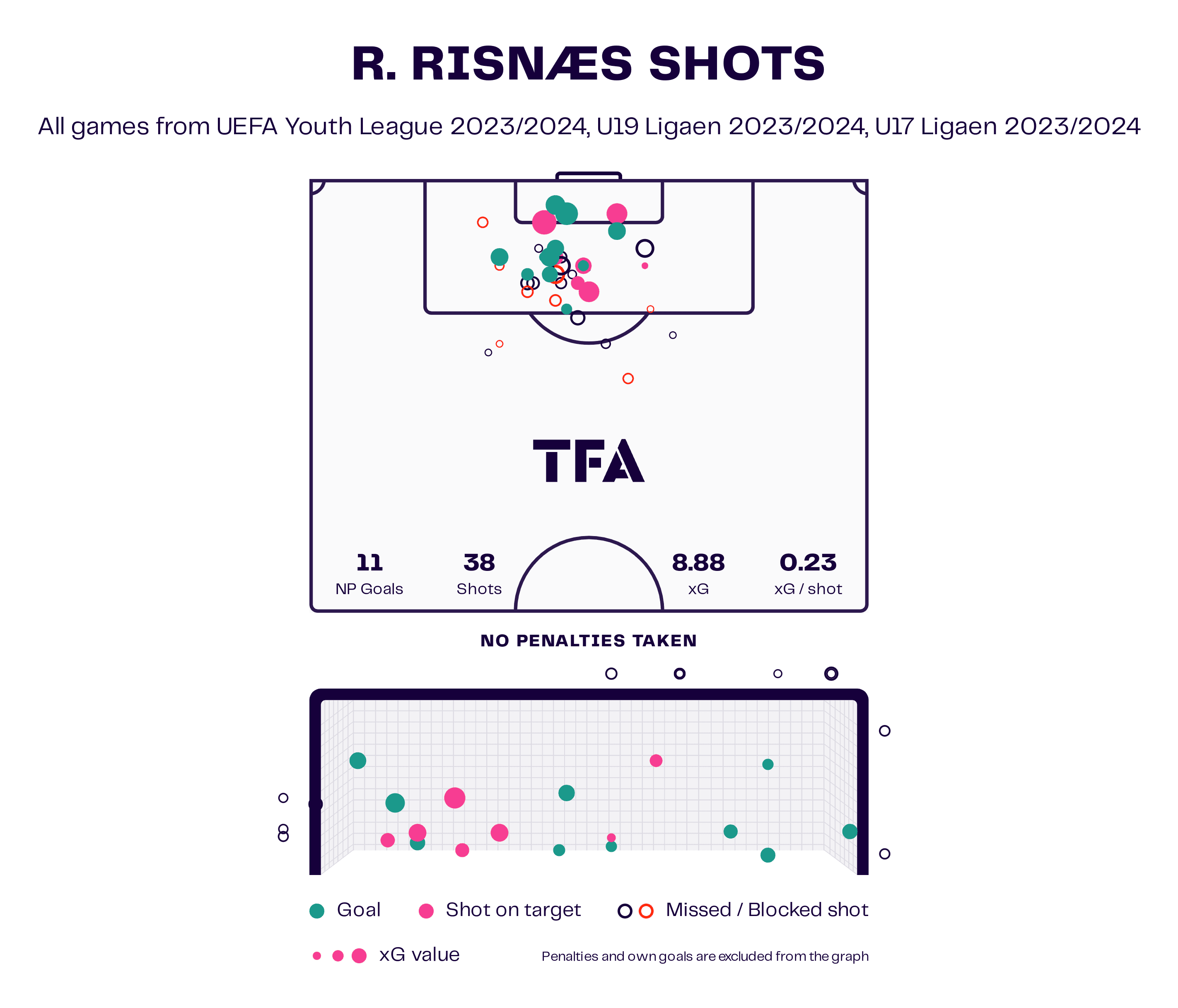
The data visual here further confirms that Risnæs mostly shoots from inside the penalty area. We can see that he has bagged 11 goals from an xG of 8.88, which suggests that he is clinical with his finishing and capable of scoring some lower percentage opportunities. This is very beneficial for his team as it means that he is likely to need fewer chances to hit the back of the net.
Attacking dynamism
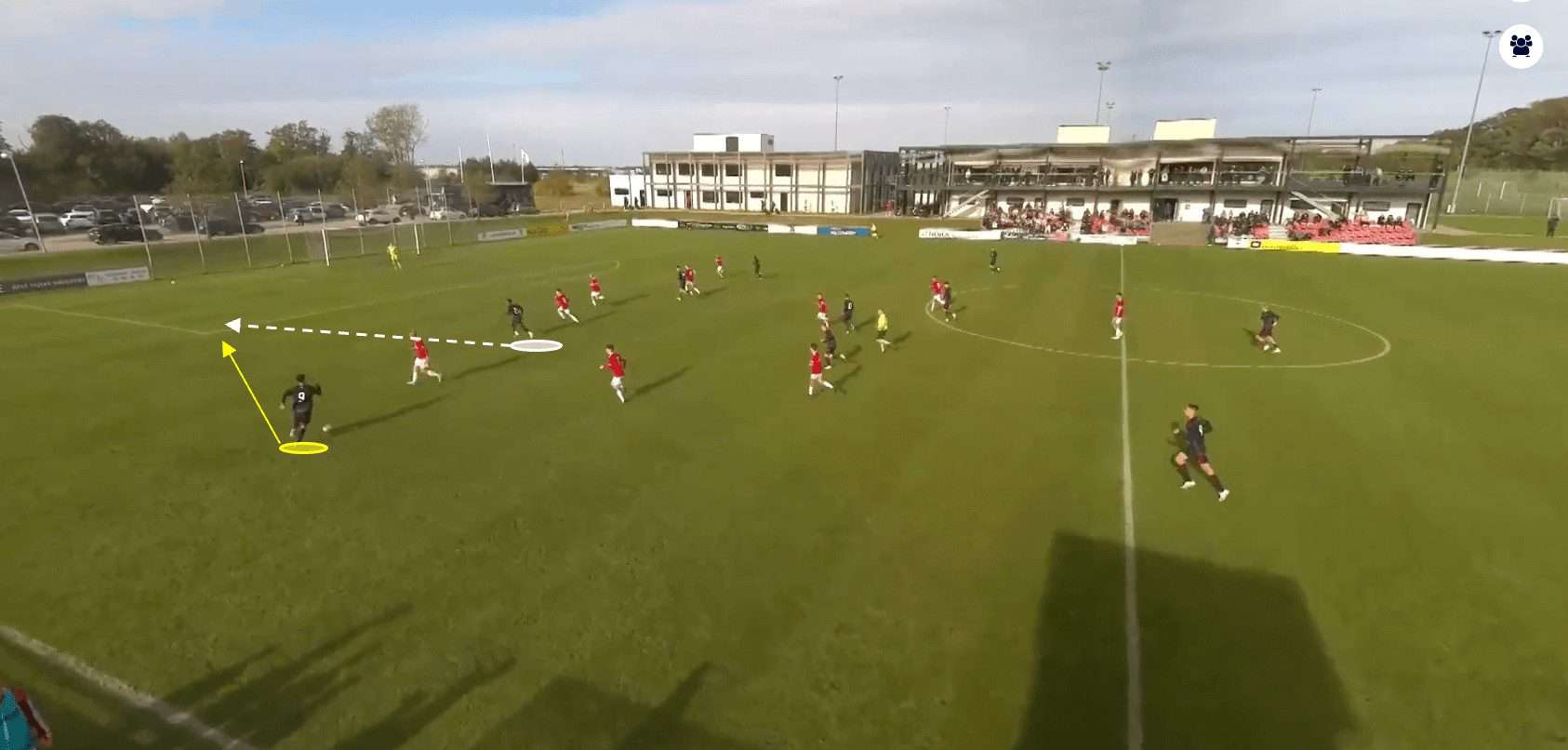
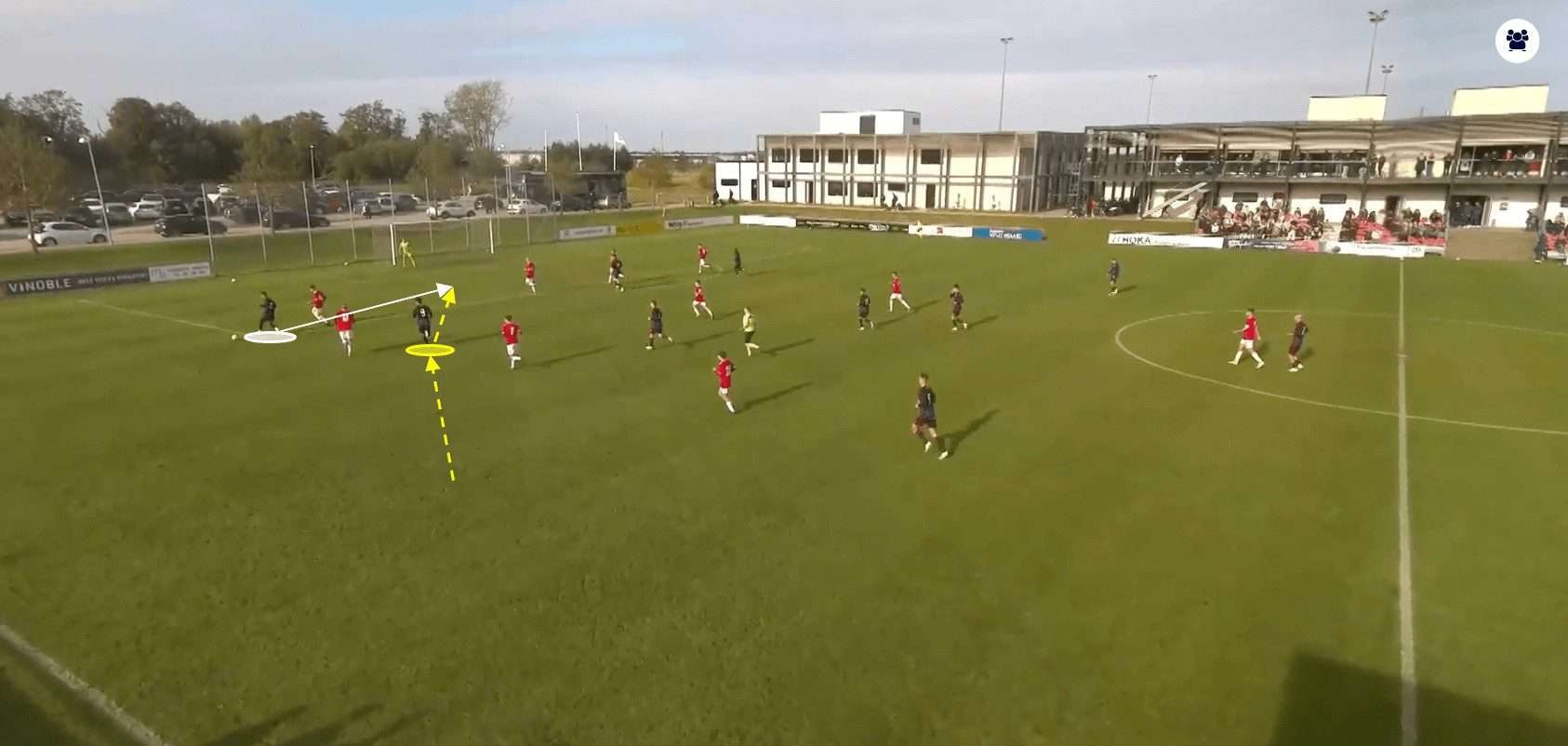
Risnæs is adept at linking up the play, enabling the team to transition effectively from defence to attack. In this scenario, he is out on the left and receives the ball as his team are looking to progress up the pitch quickly. He plays a forward pass into the path of his teammate and then makes a run into the box, anticipating the return pass.
His involvement in linking up play fosters fluidity and versatility in København’s attacking strategy. Through effective ball circulation and interplay, he contributes to creating passing outlets, maintaining possession, and opening up channels for creative attacking movements such as the one above. This interconnected style of play not only confounds the opposition but also allows the team to execute intricate attacking patterns.
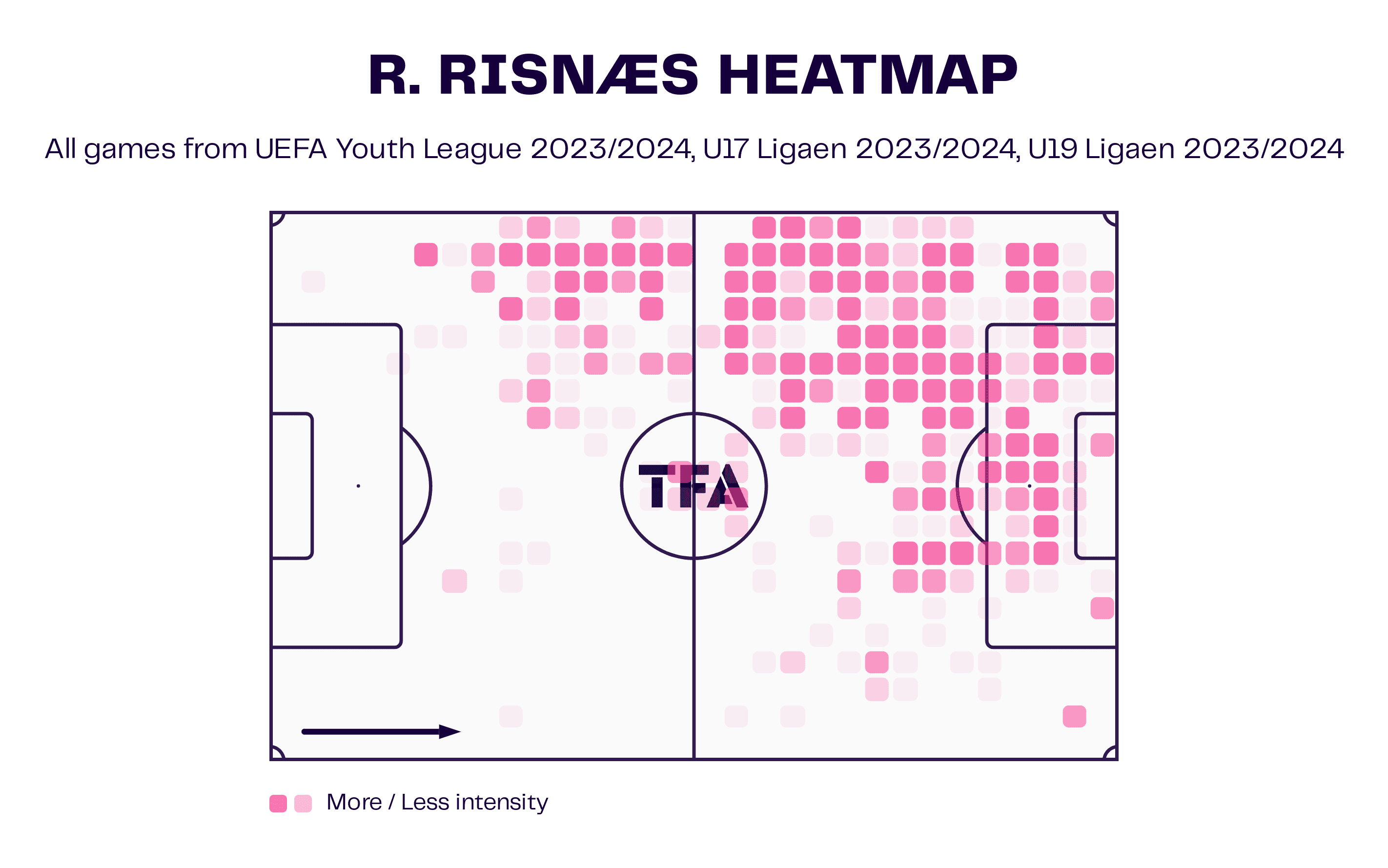
The heatmap above shows us where Risnæs has been most active on the pitch during the 2023/24 season. We can see that he primarily plays on the left or as a central striker, although there is a lot of interchange between the front line. Risnæs naturally drifts out to the left to receive the ball to allow runners from midfield to get forward into more central areas when playing as a centre forward.
He becomes a pivotal conduit in initiating attacking sequences by receiving passes, holding up the ball, and involving teammates in the build-up. This is often crucial in breaking through the opposition’s defensive lines and advancing the ball into more advanced areas of the pitch.
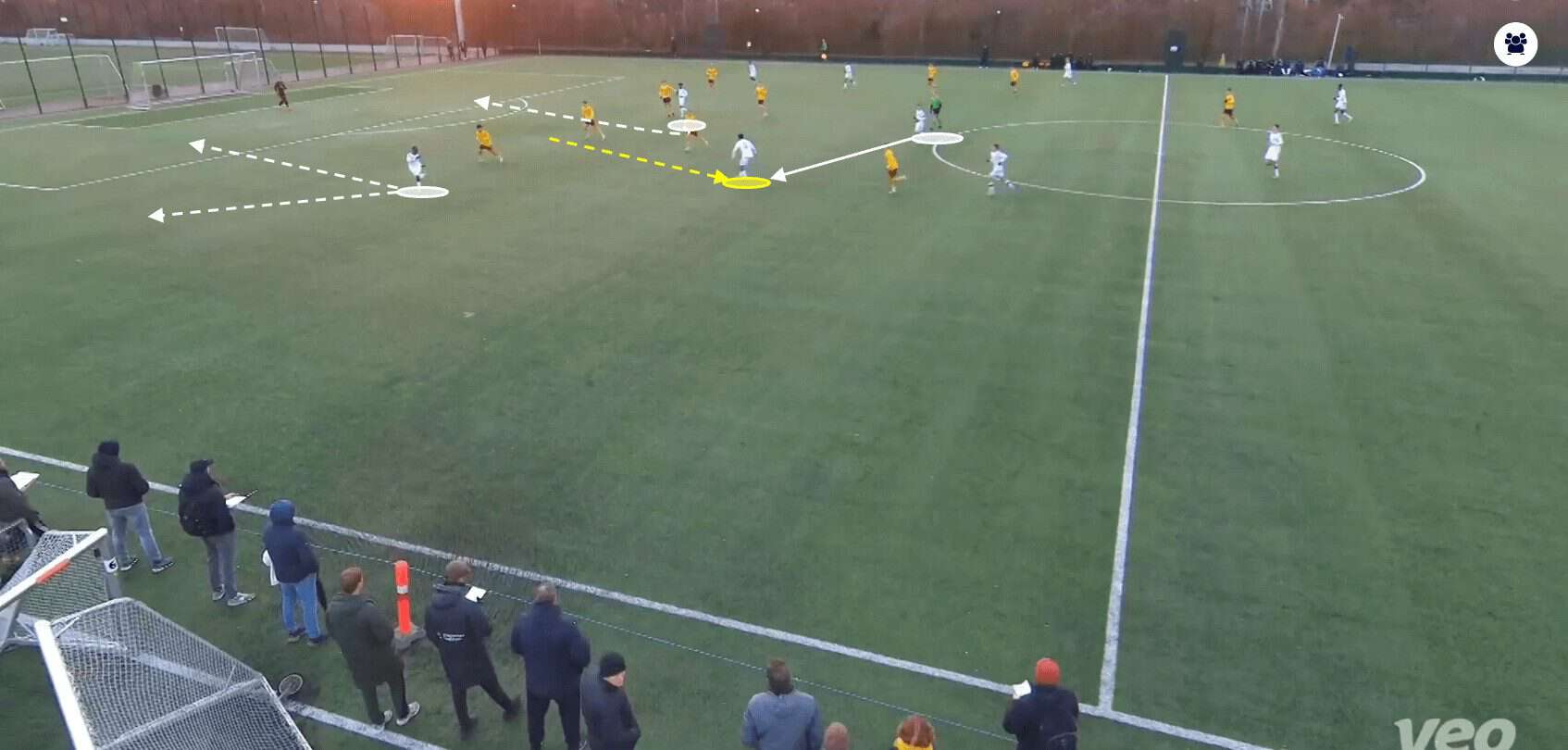
When playing as the central striker, Roberto Risnæs frequently looks to drop deeper to receive the ball. He is a player who loves being in possession and actively seeks to link up play between the midfield and attacking units. By positioning himself in a more withdrawn role, he becomes more dynamically involved in the build-up, allowing for smoother transitions from defence to attack. This ensures a continuous flow of possession and facilitates the team’s progression up the pitch.
Moreover, this can create a numerical superiority in the midfield, providing additional passing options for teammates and allowing the team to establish better control of possession and navigate through opposition defences more effectively. By operating in these pockets of space, Risnæs can receive the ball and make incisive passes or dribbles. This tactical flexibility poses a challenge for defenders, as they must decide whether to track the forward or maintain their defensive shape.
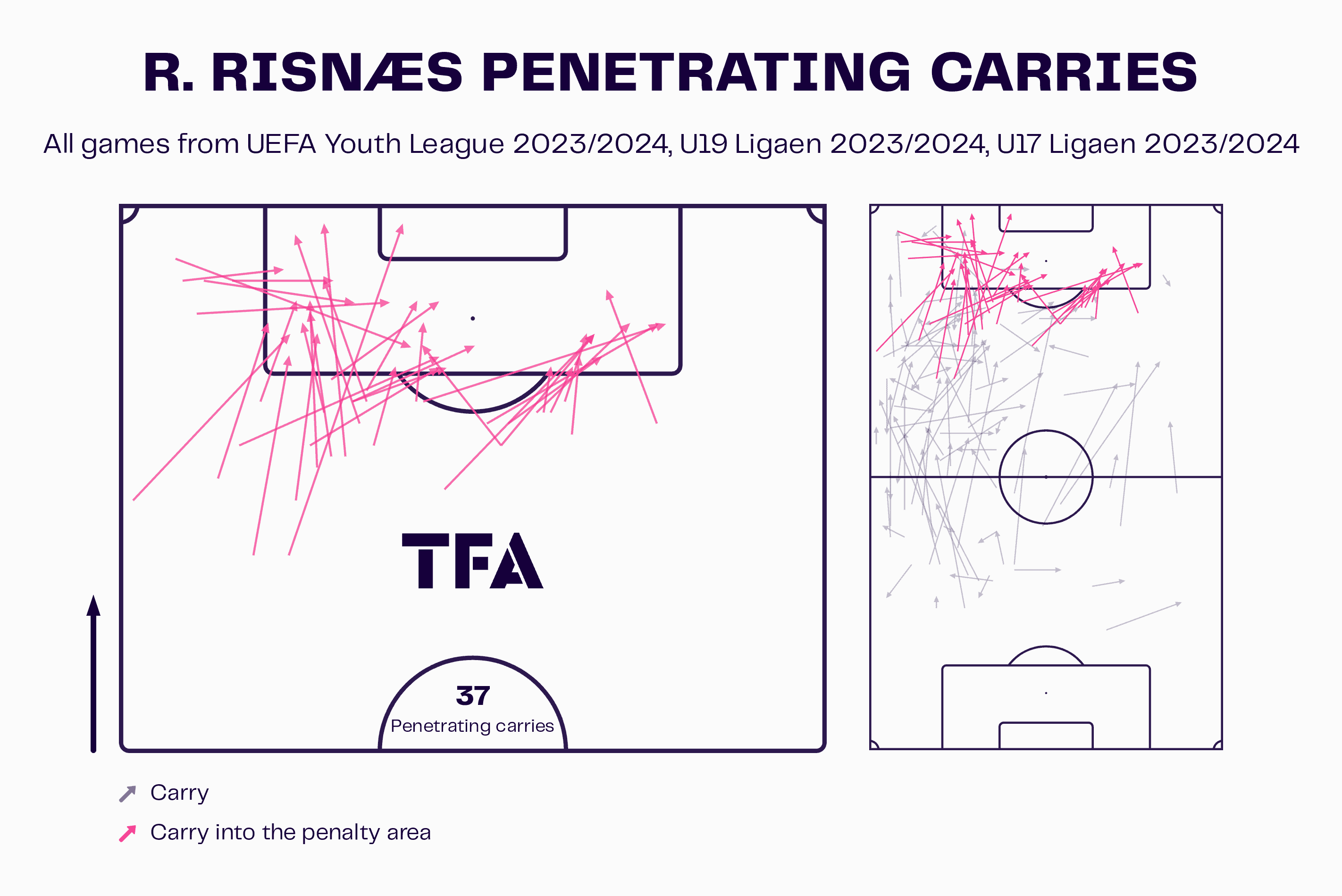
Furthermore, Risnæs consistently looks to make things happen on the pitch. When he gets the ball played into his feet, his first thought is to try and be positive with it. We can see from the data visual that he has executed 37 penetrating carries into the opposition penalty area so far this season.
This puts additional pressure on the opposition’s defence. By taking the initiative to dribble past defenders and drive into the penalty area, Risnæs forces the defensive unit to react quickly, often leading to defensive errors or fouls. His assertive playstyle creates chaos in the penalty area and increases the likelihood of København creating goalscoring opportunities.
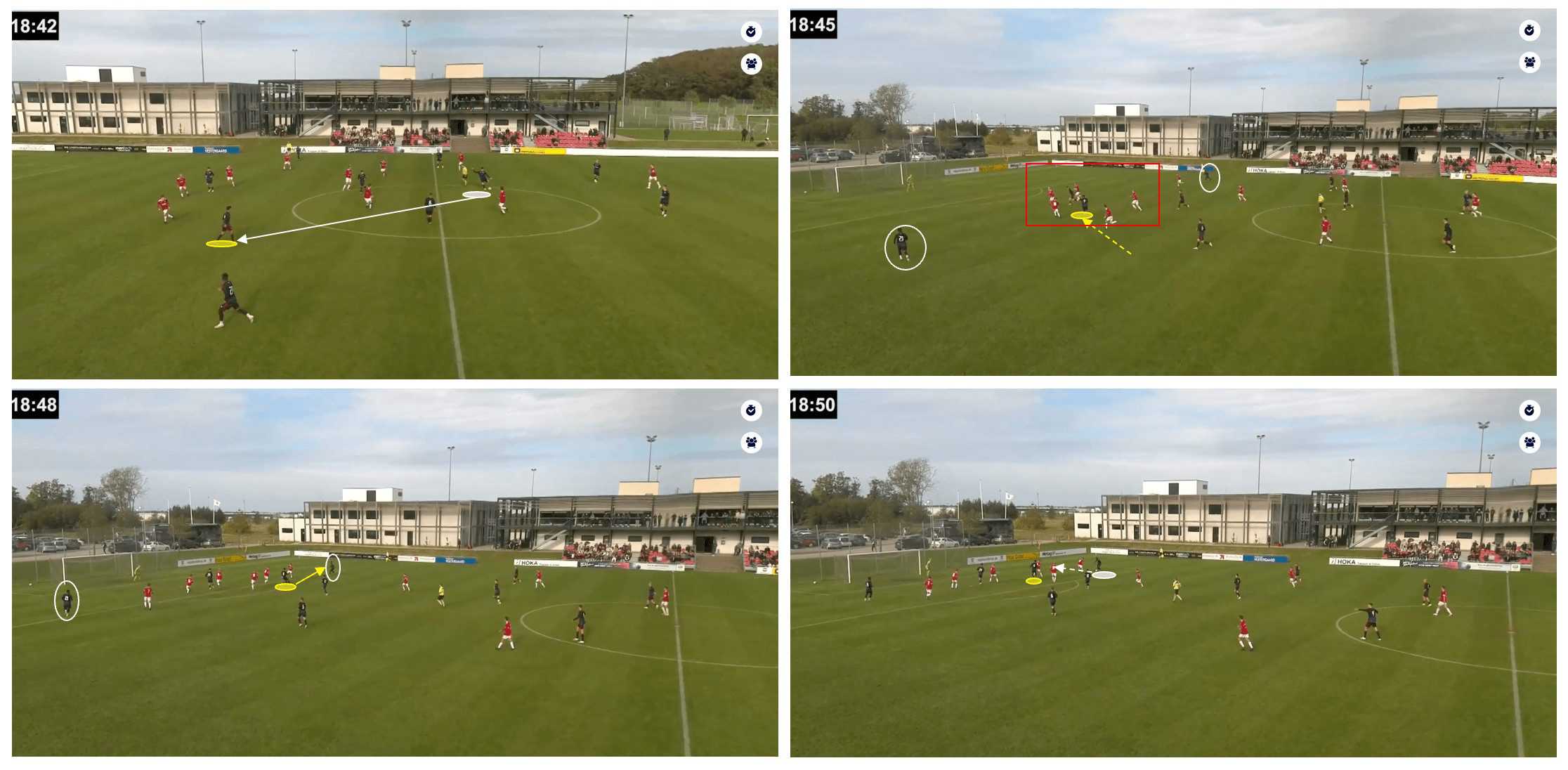
In this example, Risnæs receives a pass from his teammate and immediately looks to carry the ball forward. His close control and ability to take on his opponents (he averages 1.32 take-ons per 90) draws defenders towards him, which up spaces for teammates to exploit. In this scenario, five opposition players are drawn to Risnæs, which leaves an abundance of space in the wide areas for attacking players to get forward.
Moreover, Risnæs carrying the ball into the penalty area disrupts the defensive organisation. We can see here that he plays the ball into the path of his teammate and then moves into a central area. The young forward averages 1.01 key passes per 90, meaning he frequently plays teammates into potential goalscoring positions.
Tenacious defensive work
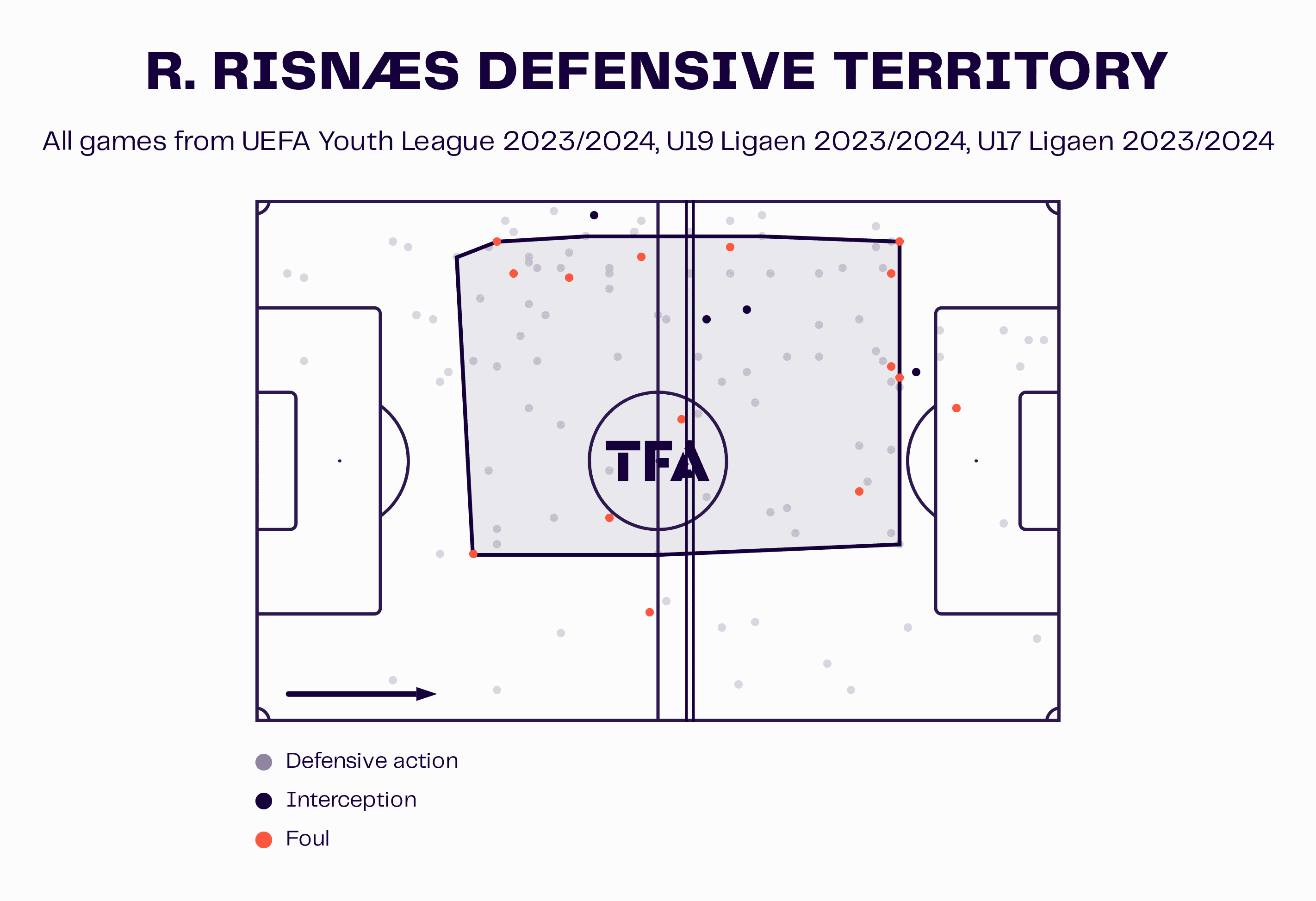
Risnæs is an incredibly tenacious player who looks to involve himself in all aspects of the game. He does not shy away from working hard defensively; the data visual above shows us where his defensive actions take place on the pitch. We know that FC København look to press high up the pitch when possible, and we have already established how effective Risnæs can be in this situation.
From the visual, we can infer that he is more than happy to drop deeper into the defensive phase to provide extra security in their defensive structure. By willingly participating in defensive phases, Risnæs aids in preventing the opposition from easily progressing through the central areas of the pitch. His defensive presence acts as an additional layer of protection for the midfield and defensive lines, making it more challenging for the opposition to break through the heart of the team.
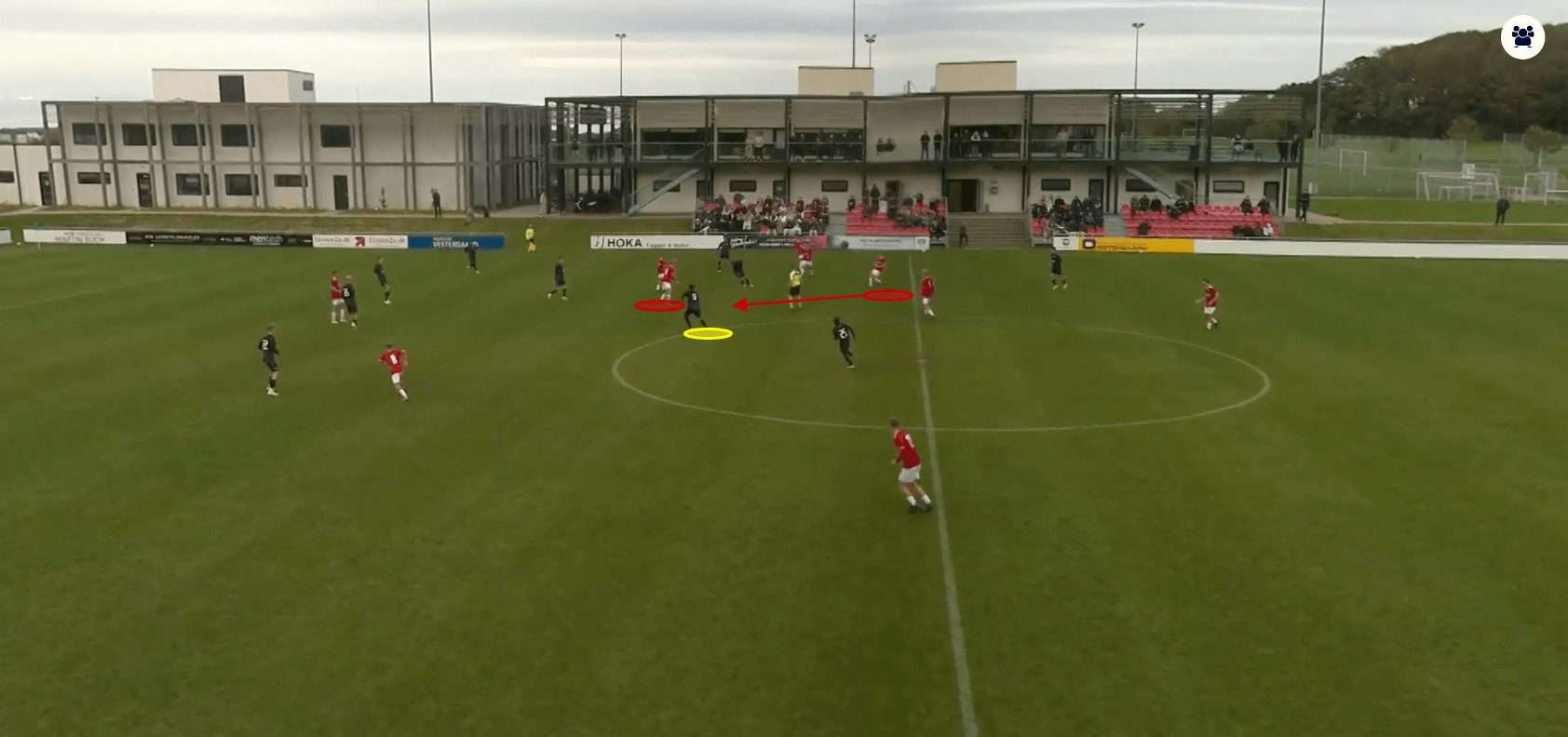
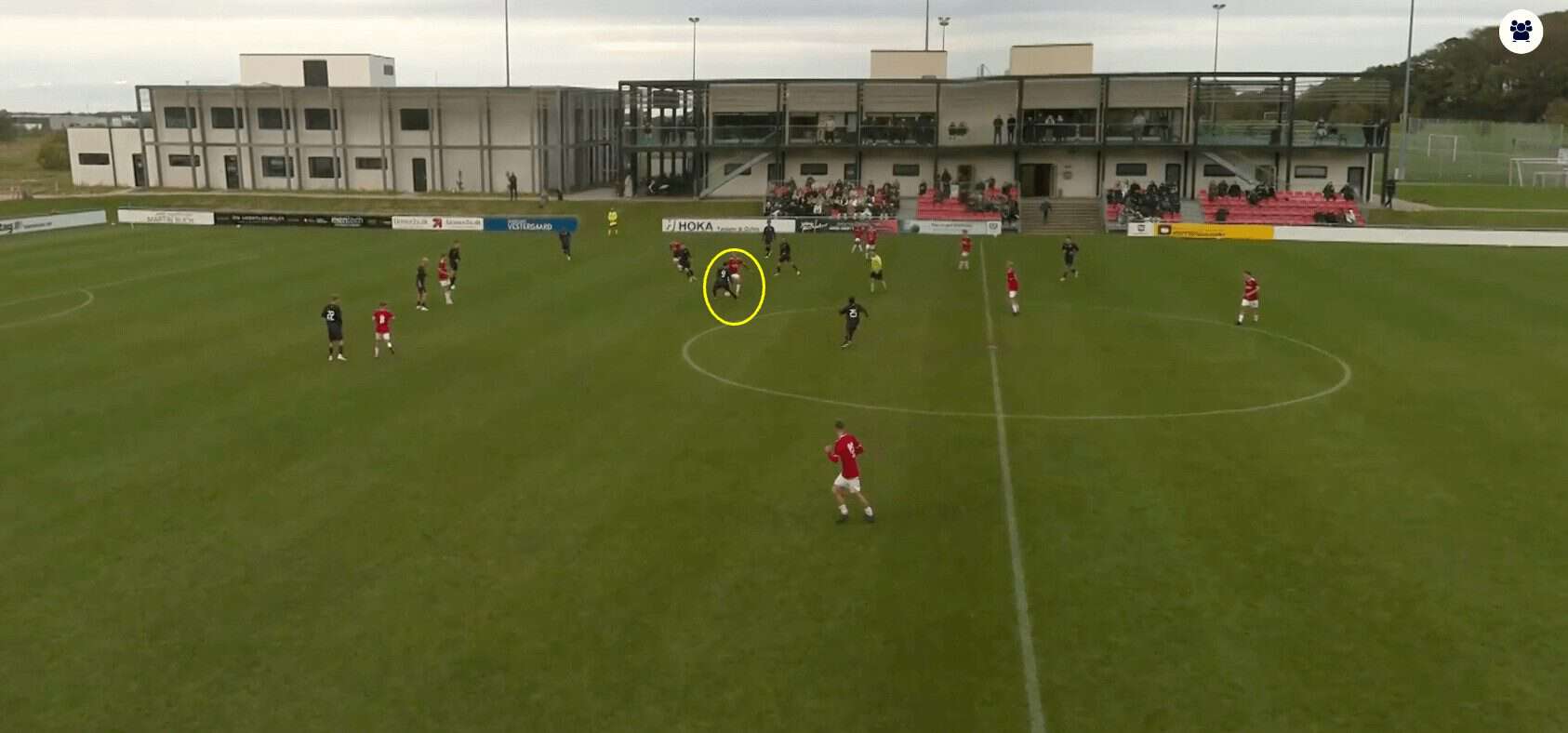
In this instance, he recognises where the danger is and acts quickly. Upon realising where the opposition player is going to aim his pass, Risnæs moves to close down the opponent receiving the ball. He puts him under pressure and does not allow him to turn when receiving possession. This limits the opponent and means Risnæs can comfortably recover the ball.
By pressuring opponents, intercepting passes, and making timely tackles, he becomes an obstacle for the opposition’s ball circulation, forcing turnovers in advanced positions. This defensive work rate directly contributes to the team’s ability to regain possession high up the pitch.
Additionally, by making tackles, averaging 2.5 per 90, and contributing defensively with his 2.5 aerial duels and 3.0 ground duels per 90, Risnæs can help to initiate turnovers and quick counterattacks. Winning the ball in advanced positions provides an immediate offensive advantage, as the team can transition rapidly from defence to attack. His defensive efforts can become a catalyst for creating goalscoring opportunities, catching the opposition off guard during moments of defensive vulnerability.
Conclusion
In this analysis, we have highlighted some of the critical elements of Roberto Risnæs’ game. We have seen how the dynamic attacker uses his speed and intensity to force high turnovers. Additionally, we have analysed his wonderful ability to progress the play and how he can change the team’s attacking fortunes in a second once he has the ball at his feet.
Although his primary role is to bring attacking flair, which he does in abundance, Risnæs does not shy away from the defensive work and shows excellent tactical knowledge and understanding when in the defensive phase of play.
He is a highly talented player who will most likely break through into the first team soon. FC København are once again showing that they know how to bring through talented youngsters with incredibly high potential.





Comments